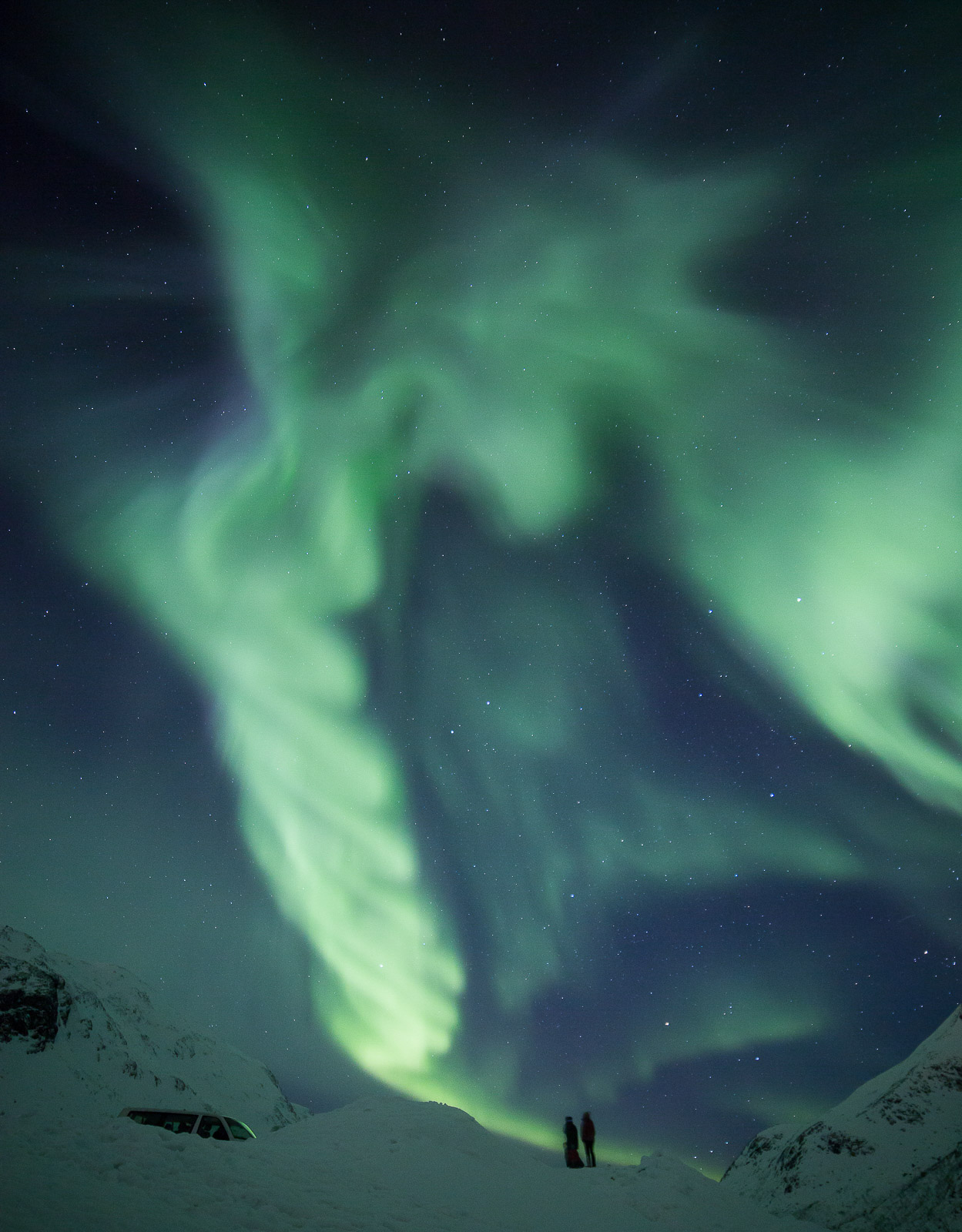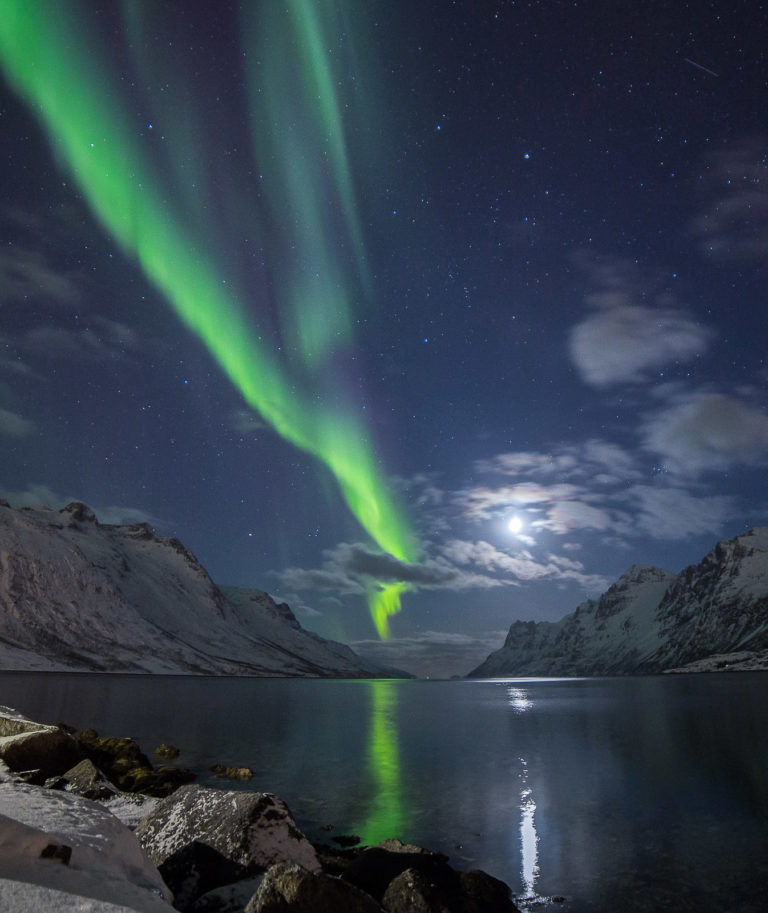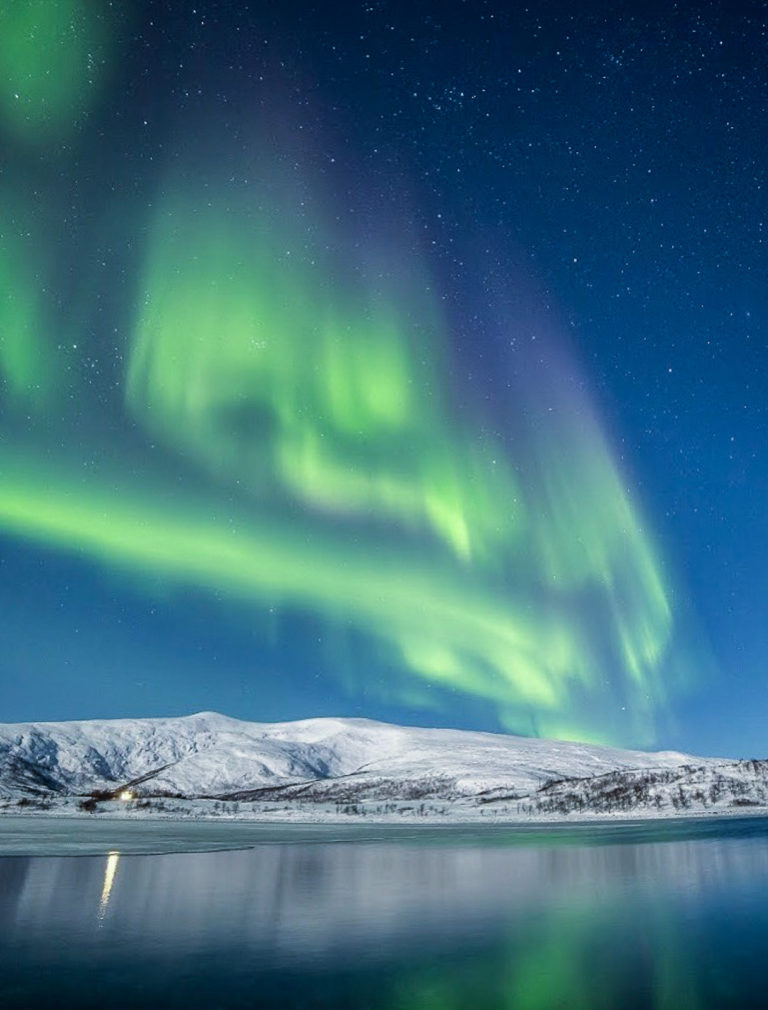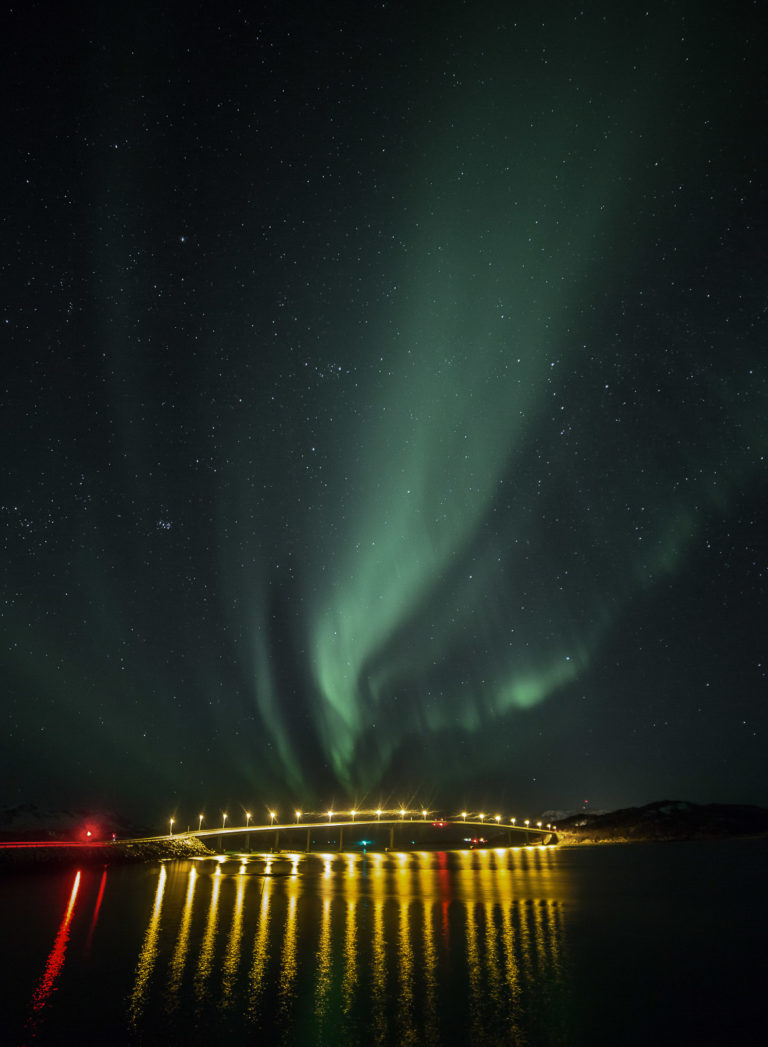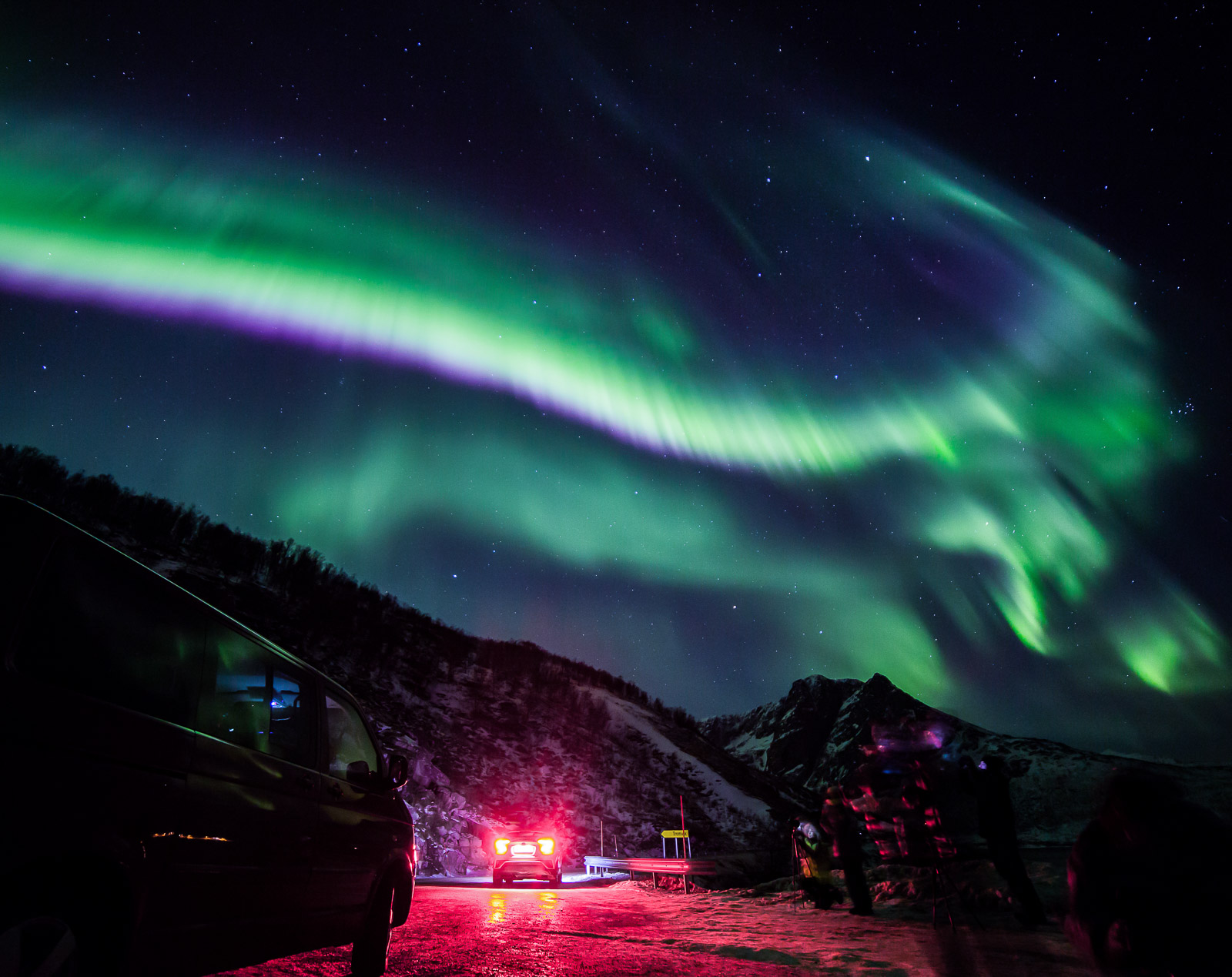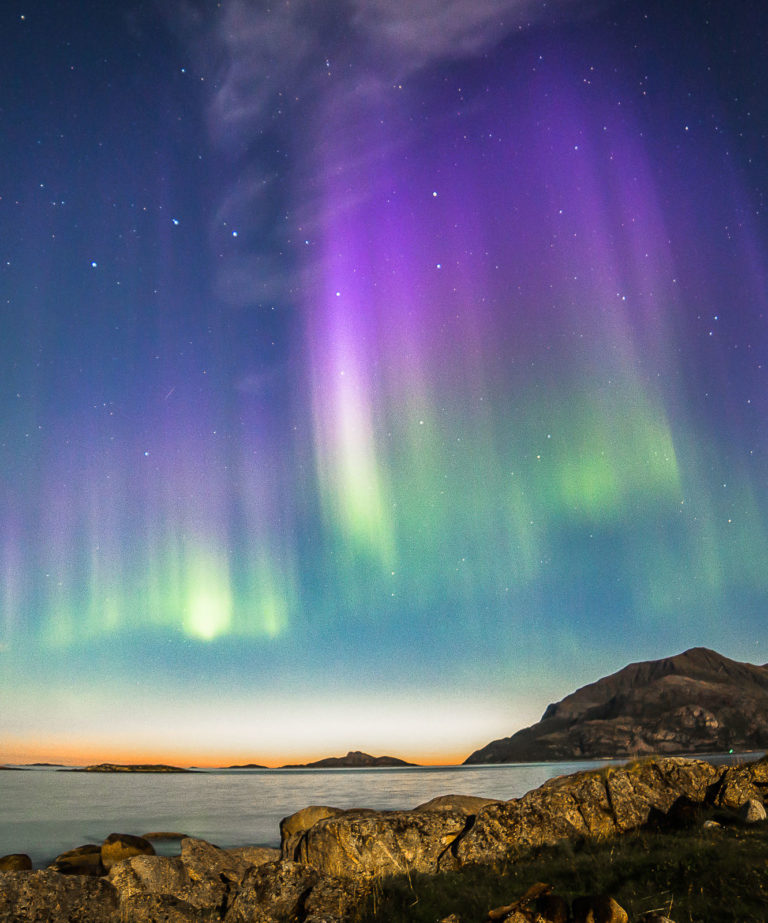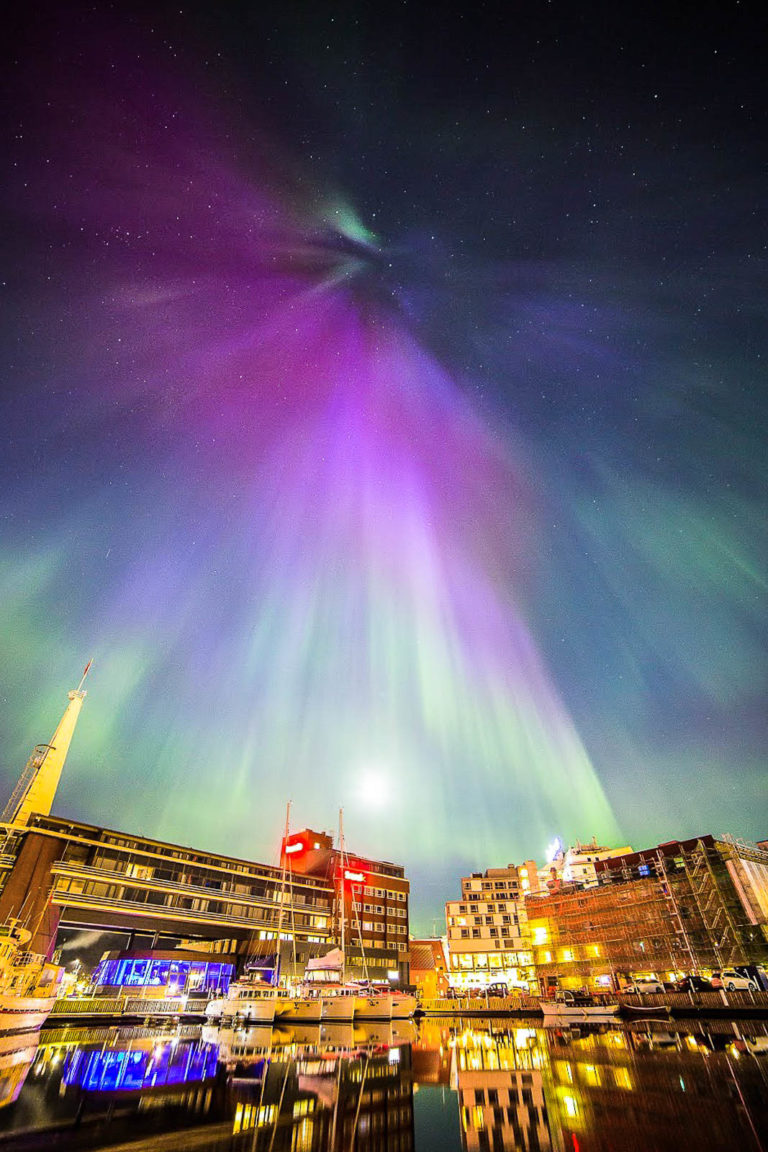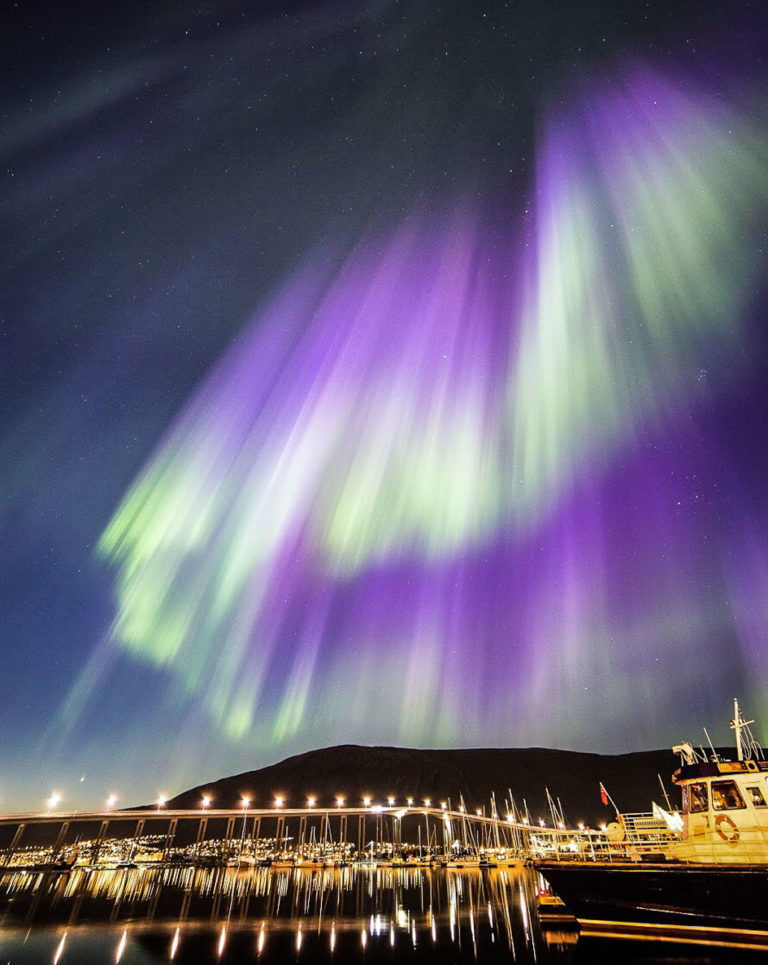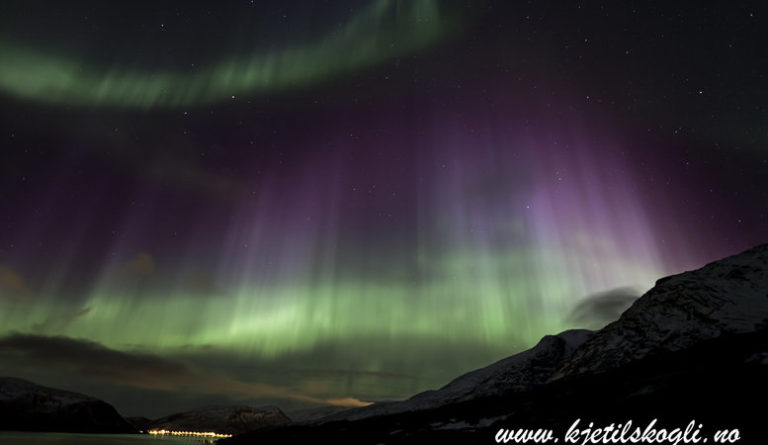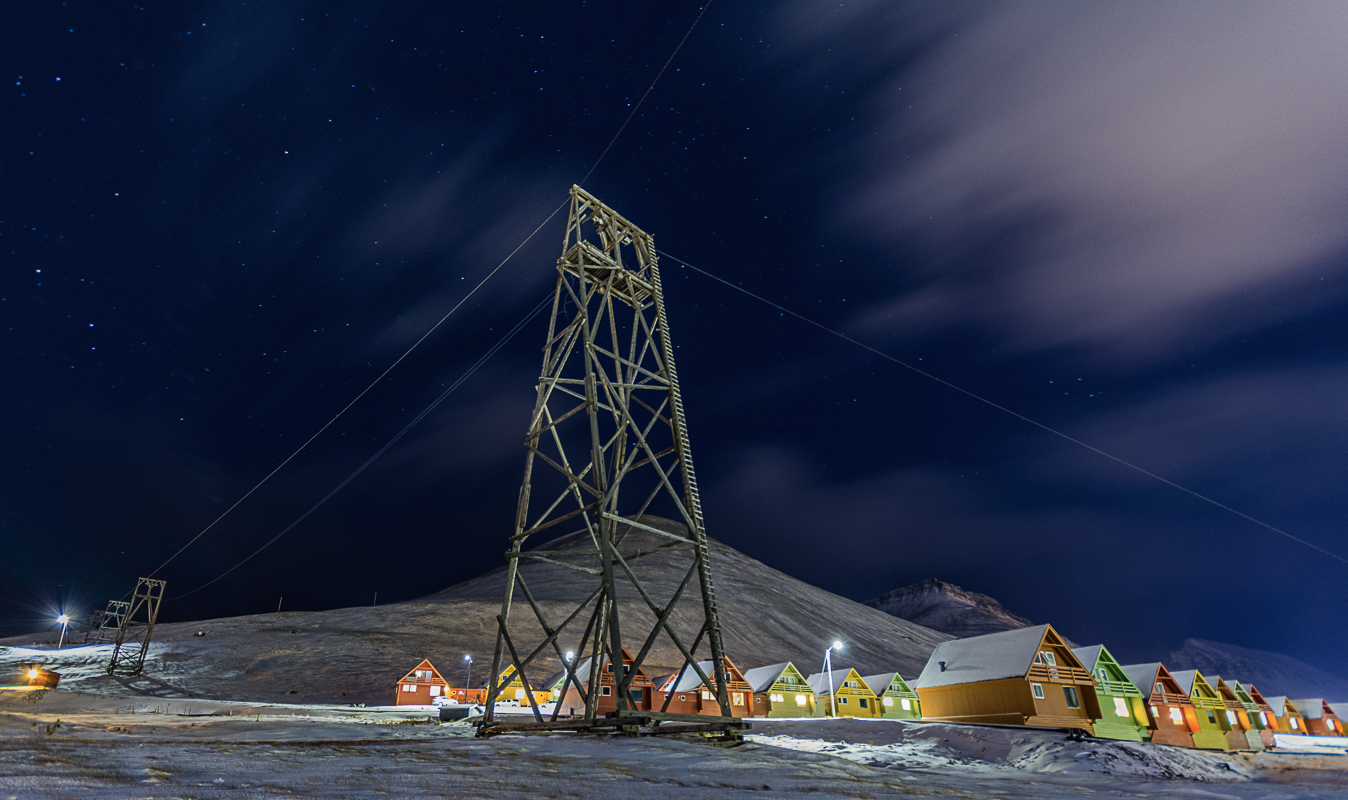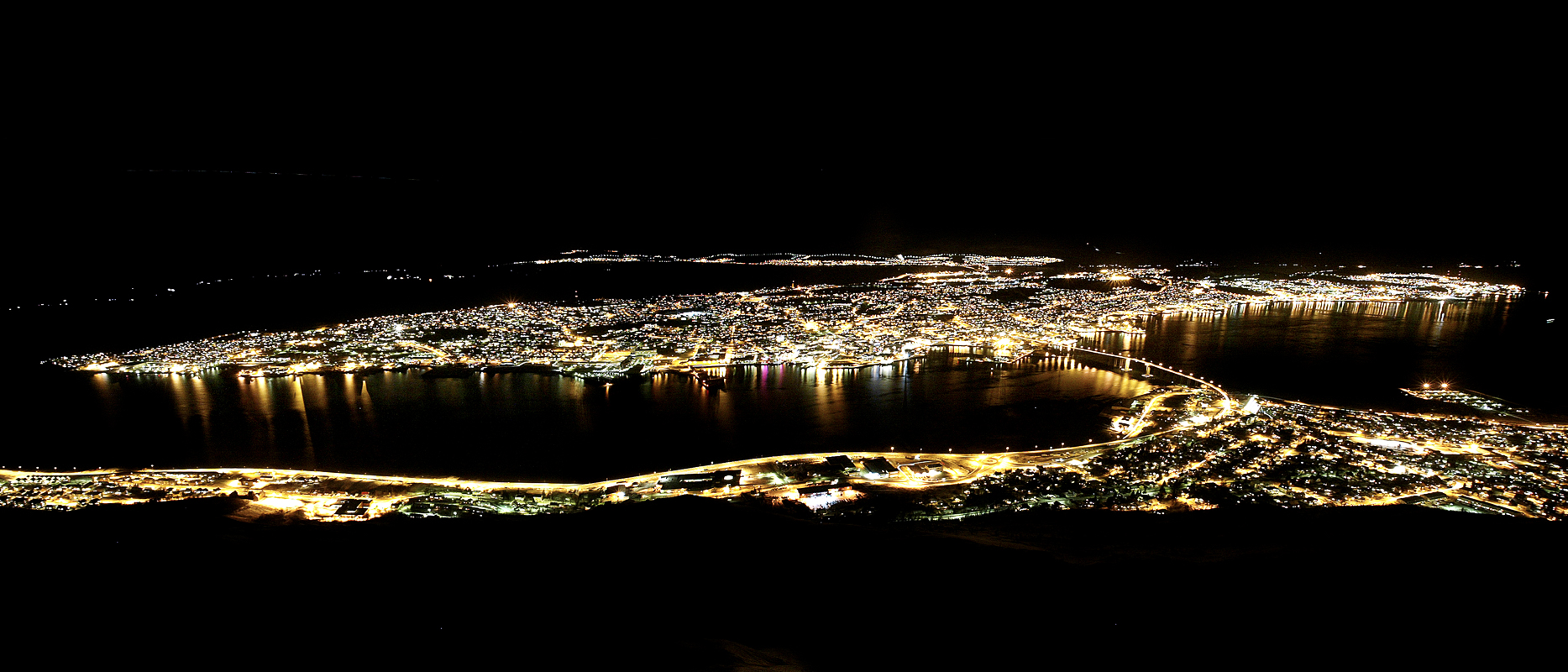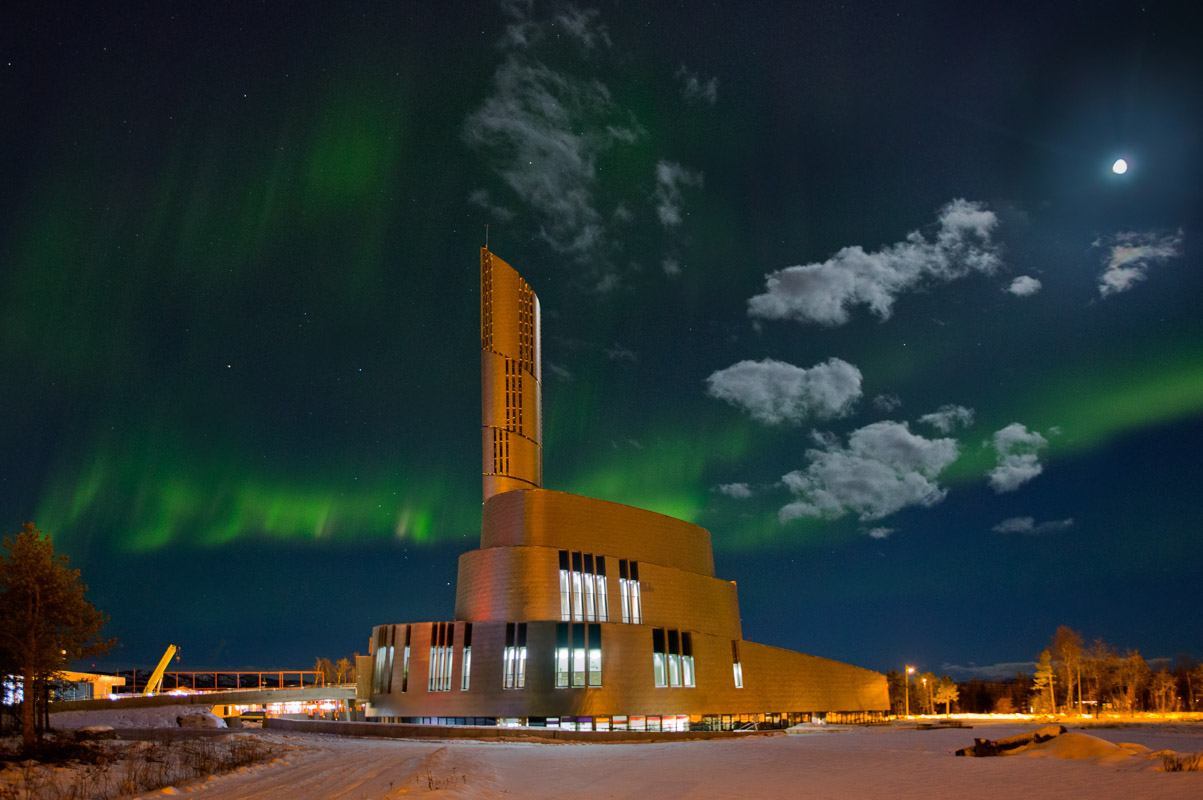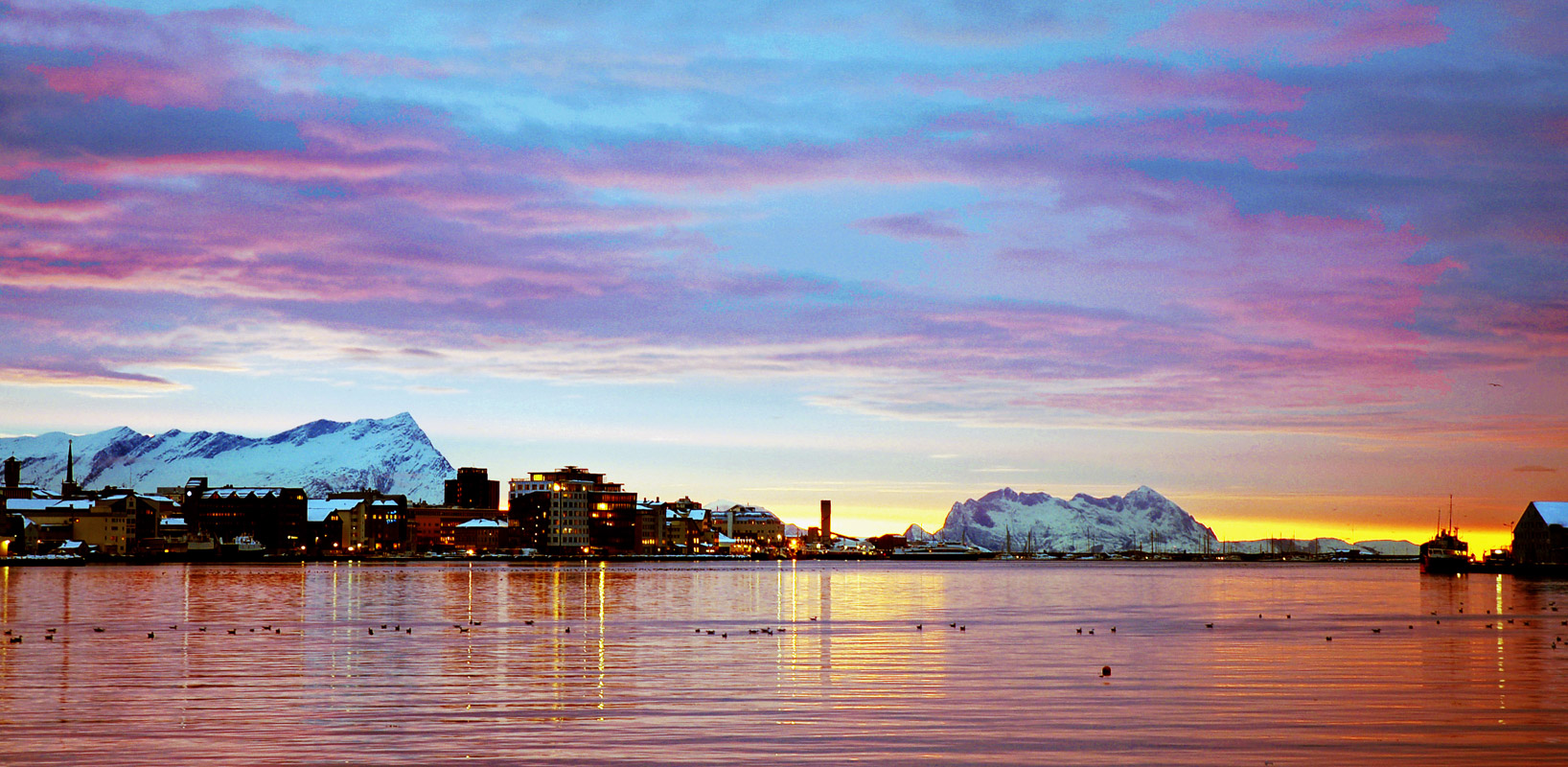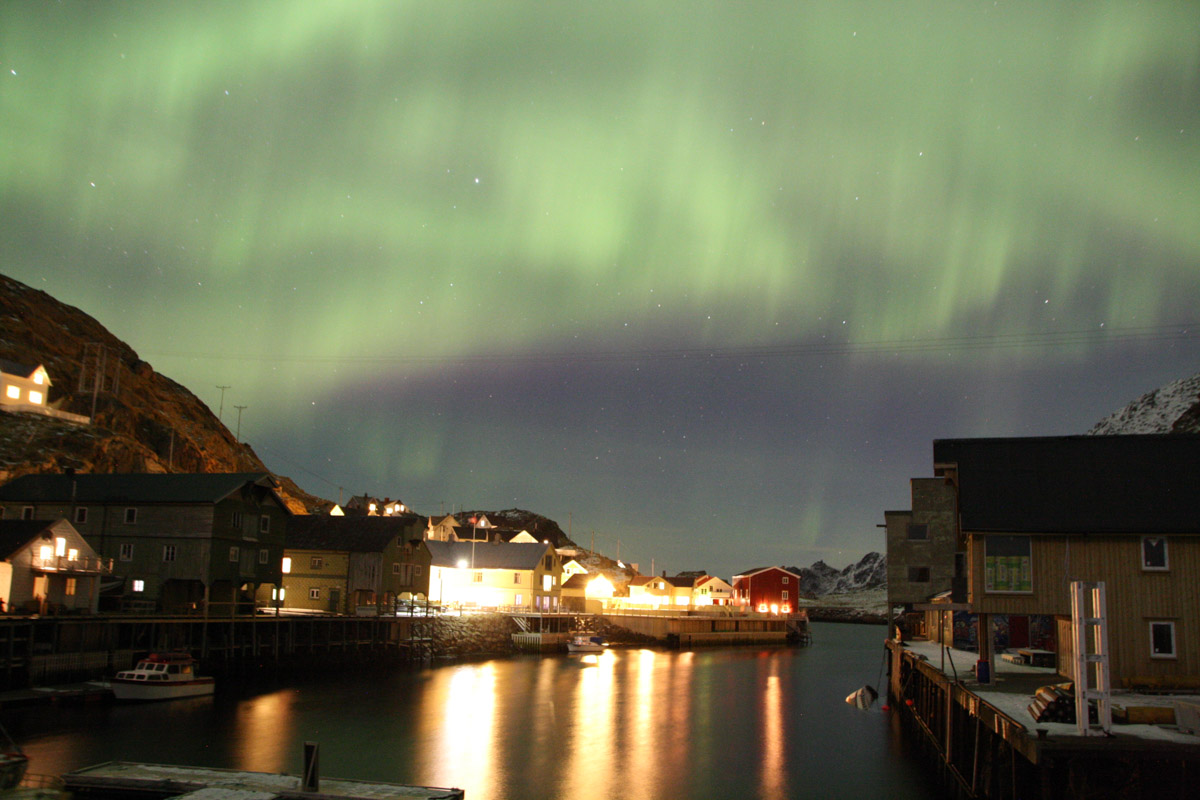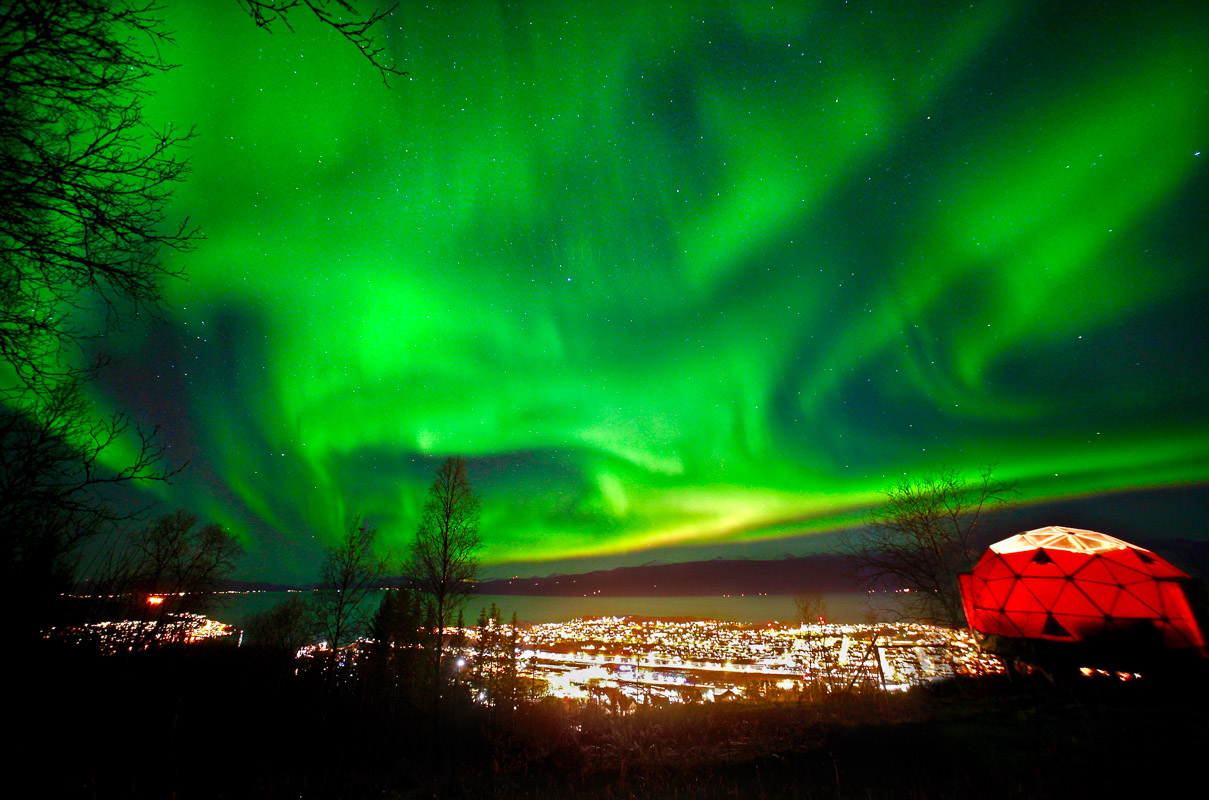What causes this phantom in the night skies over the high latitudes? The story is a complex riddle of scientific discoveries that are still taking place to this day, which can often make it difficult to understand what on Earth is going on. Therefore, this article aims to make the science a little more digestible, while throwing in some astonishing facts along the way.
The technical names for the night time displays are aurora borealis (northern lights) for the northern hemisphere and aurora australis (southern lights) for the southern hemisphere. In this article, the term northern lights will predominantly be used, but the same science applies to the southern lights that are seen around the Antarctic. The reason the southern lights can often be overlooked is due to the fact that the strongest auroras occur on the Antarctic continent itself or over the surrounding oceans and land fringes where few people are located. While in the northern hemisphere, the lights occur over highly populated areas so are seen more frequently, such as in the northern Norwegian town of Kirkenes seen in figure 1.
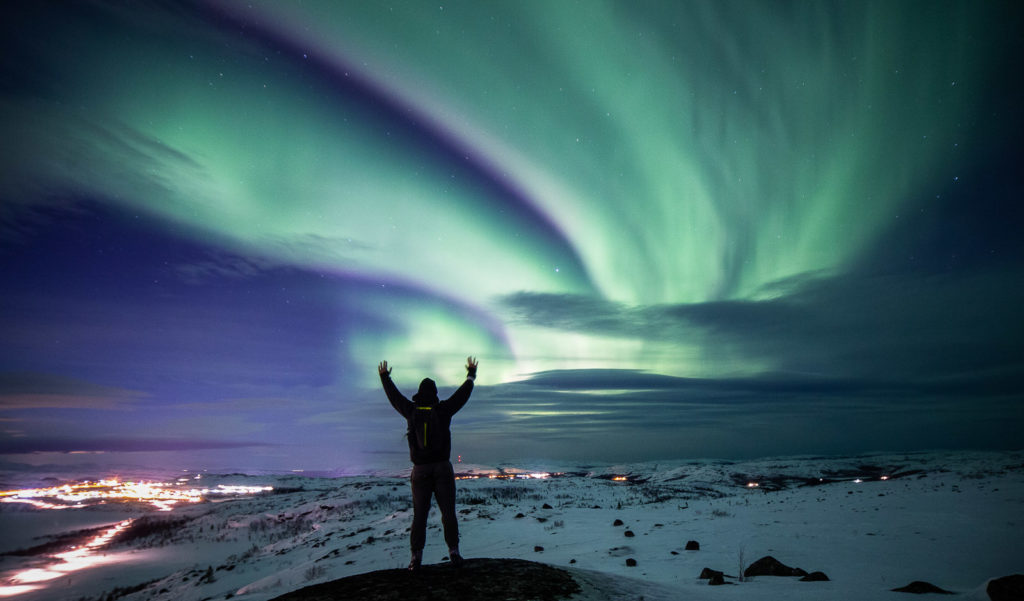
We begin our story on the sun
Our sun is a powerhouse of energy. At four and a half billion years old, this giant creates energy on a humongous scale. In the dense, hot and deep core of the sun, hydrogen is forced together by gravity to create helium, resulting in a small release of energy. This reaction occurs billions of times over with enough energy produced in 1 second to power modern civilisation for around 500,000 years! This energy makes its way to the surface of the sun and is released in the form of a stream of electrically charged particles, collectively known as, the solar wind. The solar wind can blow anywhere from 250 to over 800 kilometres per second depending on the state of the sun. There are different mechanisms and features on the sun’s surface which can cause the solar wind to impact Earth and create the northern lights, these are summed up in figure 2.
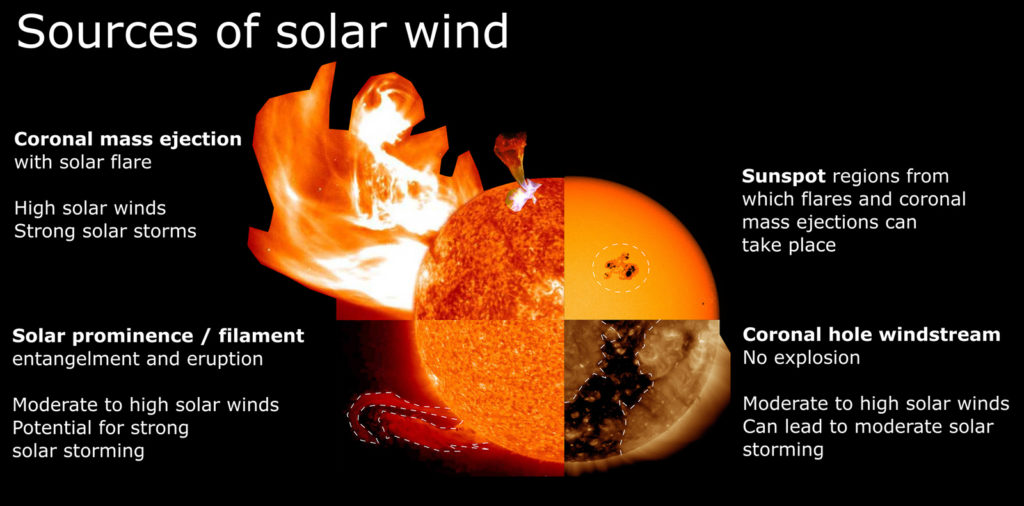
The sunspot cycles are are all hyped up
Now this wouldn’t be an article on the northern lights if we don’t discuss sunspots! A sunspot is an area of high magnetism on the sun’s surface which can release large eruptions of solar material into space called coronal mass ejections, as can be seen in figure 2. Sunspots can easily be seen by scientists from Earth and are identifiable as dark spots on the sun’s surface (figure 3). We have a long record of sunspot numbers on the sun as far back as the 1600s, yet there is a lot of misinformation out there about sunspots and the aurora, mostly with regards to the 11 year solar cycle.
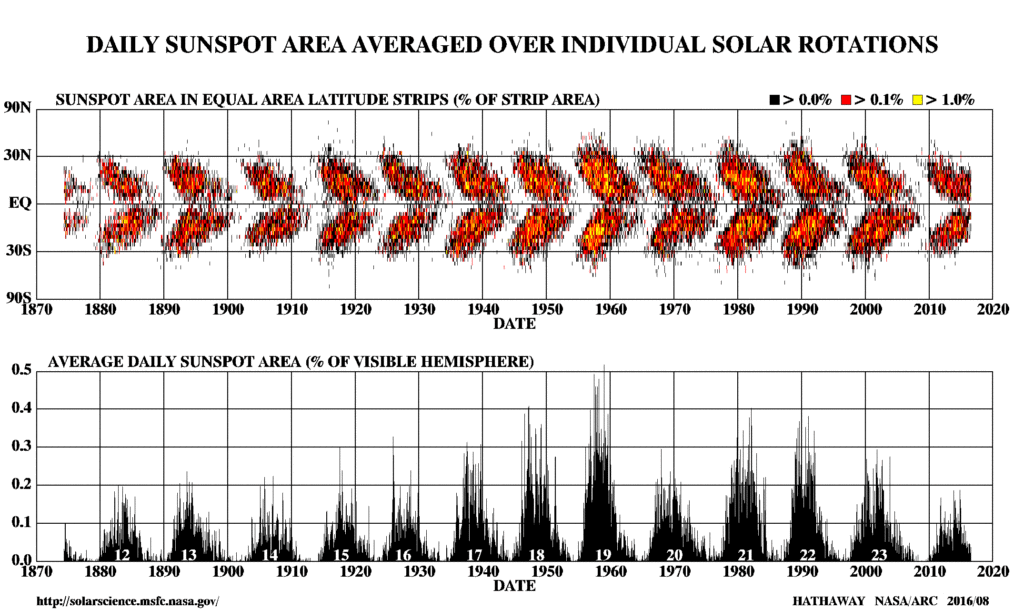
No sunspots does not equal no northern lights
Around every 11 years, the magnetic field of the sun flips so the north pole becomes the south and the south becomes the north. During each cycle there is a solar maximum (many sunspots) and a solar minimum (few to no sunspots). Many believe that around solar maximum is the best and only time to see the aurora, this is wrong. Yes, solar maximum will provide many big solar storms, but solar minimum isn’t devoid of northern lights. In fact, during this last minimum from 2017-2020, we have witnessed some incredible displays of the northern lights over Northern Norway (see figure 4).
Many also believe that sunspots are the only way the solar wind can cause auroras on Earth, also false. Coronal holes, coronal mass ejections from solar prominences and slight fluctuations in the incoming solar wind can produce intense auroras without the need for sunspots. The next solar maximum is expected to peak between 2022 and 2026, when we can expect more frequent solar storming.
The Solar wind heads towards Earth
All that material spewing from the sun spreads out into Space in all directions. A fraction of it will hit Earth, becoming entangled in our magnetic field. You may remember from school science classes taking a magnet and putting iron filings around it. Imagine those iron filings are the solar wind, and the magnet is Earth, it is the same principle. The iron collects around the corners (polar regions) of the magnet in the ‘north and south’, while on the sides of the magnet (equatorial regions), few collect. In figure 5 you can see that Earth is essentially a giant magnet with the solar wind following invisible magnetic field lines down to Earth. The Polar regions are open to particles, while the equatorial regions are protected by our magnetic field.
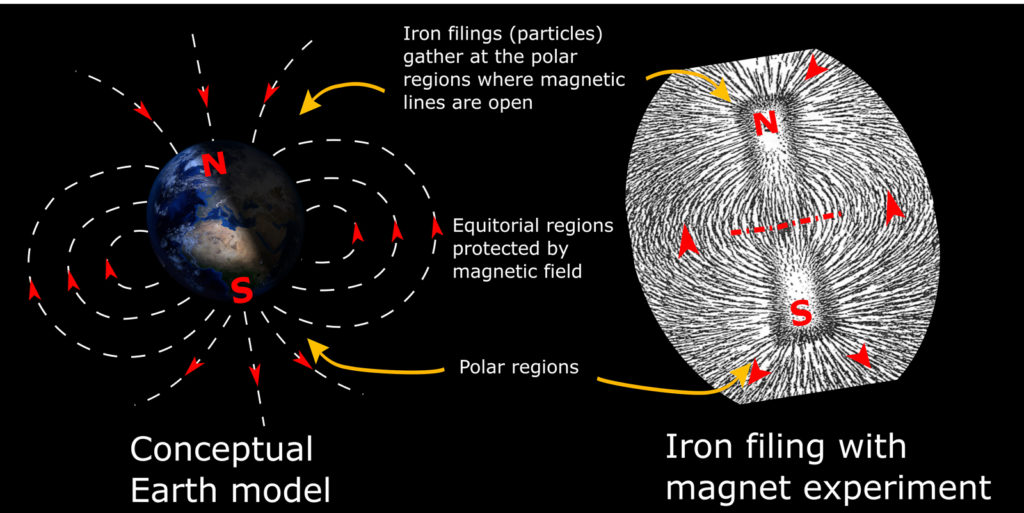
There are four main stages that lead to auroras on Earth
Stage 1 – Particles from the sun hit Earth and follow invisible magnetic lines right down onto the daytime side of the poles, this creates daytime aurora (Figure 6). Daytime aurora can only be seen during the polar night in high latitude locations such as Svalbard.
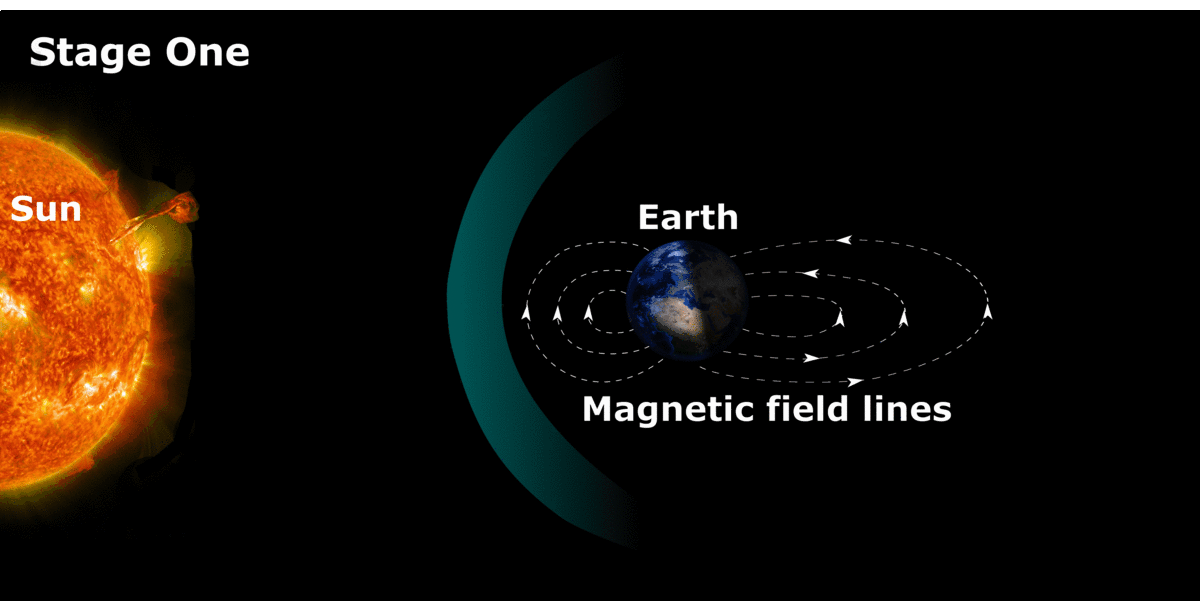
Figure 6 – Initiation of daytime auroras
© William Copeland
Stage 2 – Magnetic lines on the dayside of Earth break and our magnetosphere extends outward on the night side of Earth, the same with a flag in strong winds. Solar particles follow these lines like beads on a string (Figure 7)
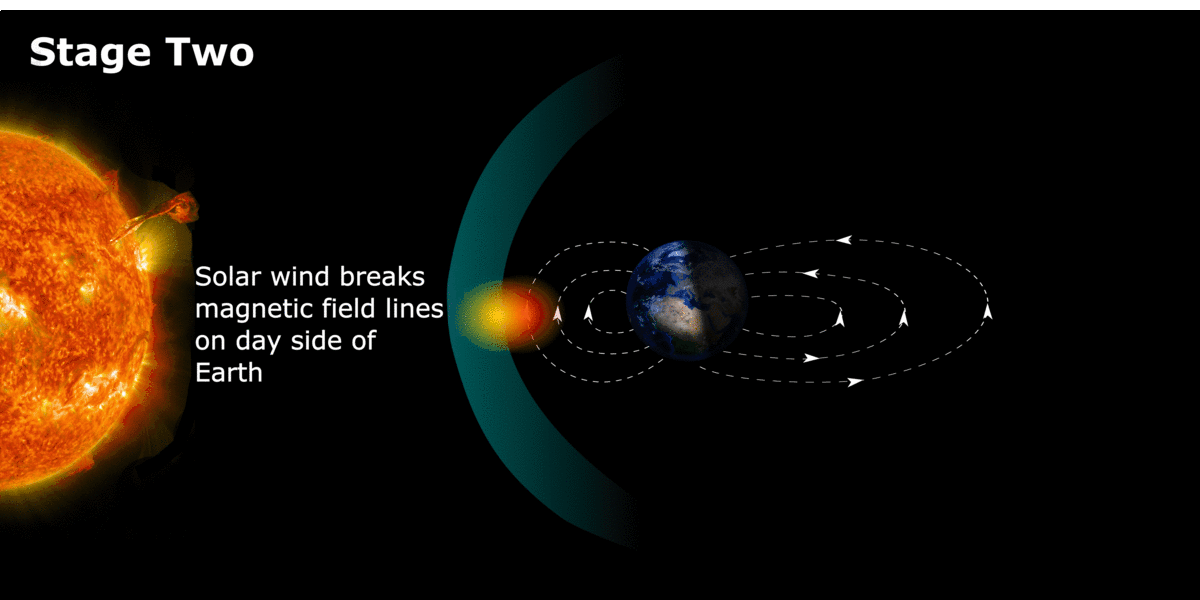
Figure 7 – Breaking of magnetic lines
© William Copeland
Stage 3 – At some point the magnetic lines come together and join up on the night side. The same principle applies to wind around a building, if you stand right next to a building on the downside of the wind you will feel nothing, but eventually as you walk away from the building you will start to feel the wind again as the path of the wind reconnects. When this reconnection happens, the particles of the solar wind flood back towards Earth as they have nowhere else to go (Figure 8).
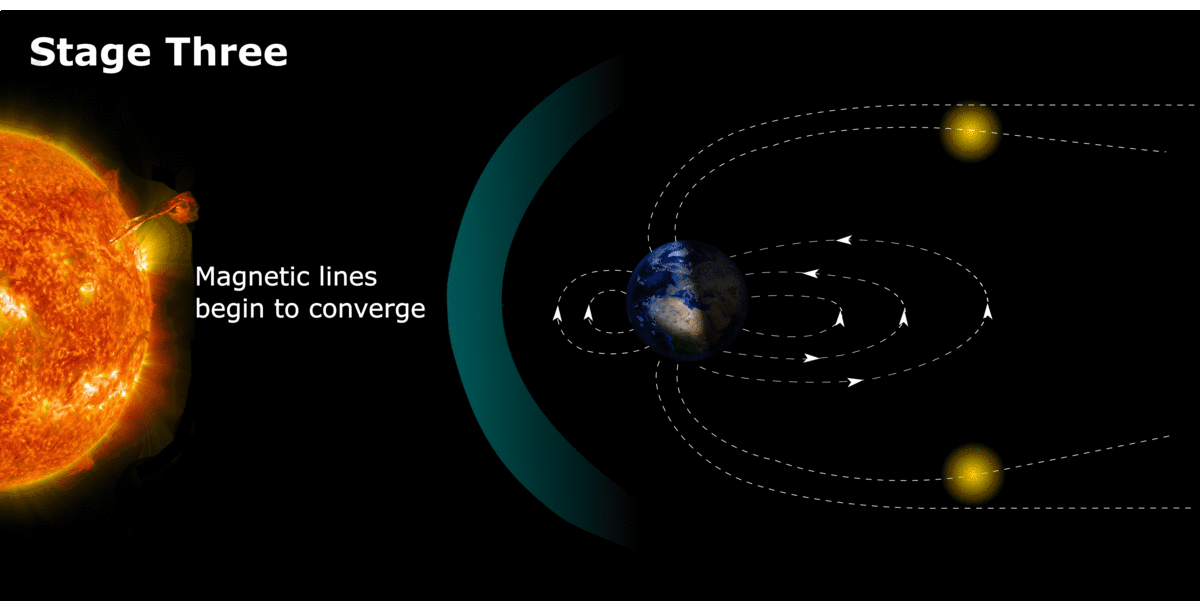
Figure 8 – Magnetic lines reconnect
© William Copeland
Stage 4 – The particles rain down and interact with gasses in our atmosphere to create the light show between 75 and 800km above Earth’s surface. At different altitudes, various colours are created by interaction of electrons in the solar wind with atmospheric gasses as seen in Figure 9.
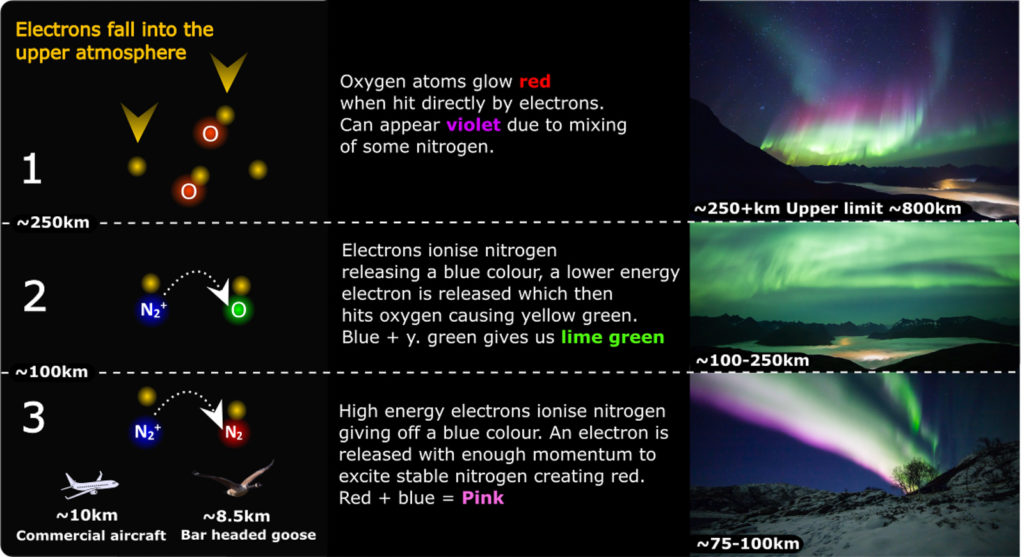
Where on Earth can you see the lights?
As the particles fall into our atmosphere they follow a path that brings them down towards specific latitudes that we call the auroral oval (Figure 10). The northern auroral oval extends across northern Scandinavia, northern Iceland, central Canada, Alaska and northern Russia, around 2500km out from the geomagnetic pole. After around 75 degrees north you have to look south to see good displays, while on the North Pole itself at 90 degrees it’s extremely rare to see the northern lights.
Northern Norway is directly under the oval
Lucky for us in mainland northern Norway we are located directly under the aurora oval, meaning high chances of seeing the northern lights all winter long. Some believe that going to Svalbard increases your chances of seeing the northern lights, this isn’t strictly true. Svalbard is on the cusp of the northern section of the oval, while northern Norway is underneath or just south of the oval. Both are great places to see the northern lights, but the mainland has more of the explosive displays. However, with 24h darkness in Svalbard during the winter, your time window to see the lights is as large as it can be, meaning chances are improved here, not to mention daytime aurora!
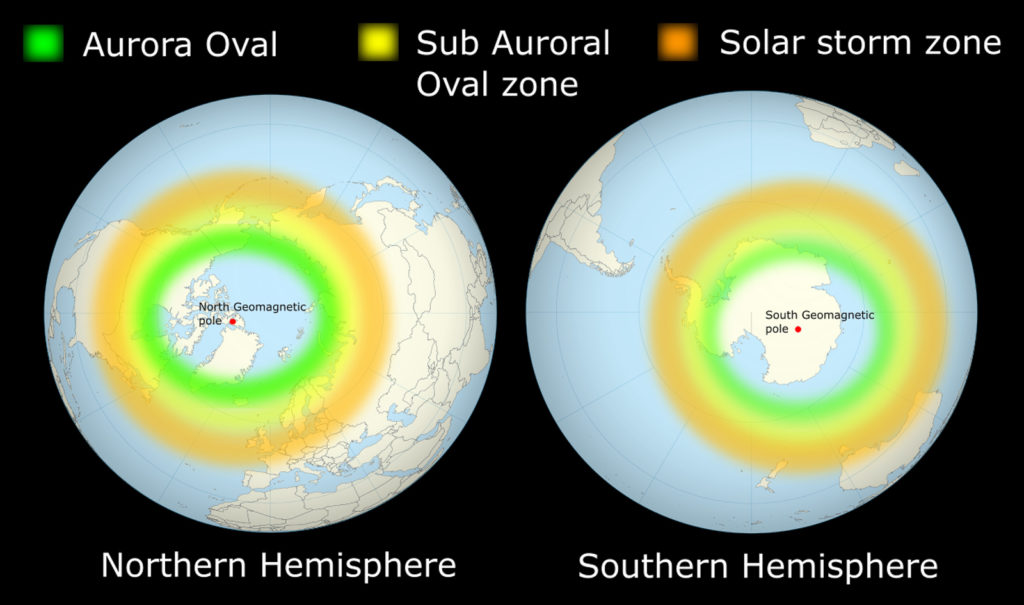
What is the obsession with the KP index?
Some of the most frequently asked questions received by northern lights guides are, what is the Kp index tonight? The Kp index is only 1, so is there any point in going out? What is the Kp index this evening? Let me stop you right there. Nearly every app, website or company touts the Kp index as the holy grail of northern lights viewing chances. It’s not, in fact for areas directly under the aurora oval such as northern Norway, Kp can be fairly insignificant.
So what is the Kp index?
So what is the northern lights – Kp relationship? The Kp is actually a measure of how much energy the solar wind is putting on our magnetosphere over a period of time. This is based on worldwide measurements of the deviation in the horizontal component of Earth’s magnetic field. Put simply, how far south we can actually see the lights. The scale goes from 0 (only directly under the oval) to 9 (latitudes as low as southern US states and the Mediterranean). The faster, higher density or more favourable magnetic field characteristics of the solar wind, the higher the Kp. However, what is important to note, is that even with a Kp of 0, auroras can be observed directly under the oval, such as in Northernmost Northern Norway.
The Kp is not the be all and end all for your northern lights chances
Try not to get bogged down when using aurora forecasting apps, there are many more important factors, such as weather conditions, that play a bigger role in your chances of seeing the northern lights. However, for those to the south of the aurora oval, the Kp is important to an extent. But as KP is an average over time, these imaginary boundaries of where you can and can’t see the lights become fairly inaccurate for aurora viewers. Within the average time it takes to measure KP, short term fluctuations in activity can mean aurora is seen well into Europe for a short time, while the KP only reaches 3 or 4 for example. So don’t rely on the KP for viewing aurora, live data from satellites is far more important.
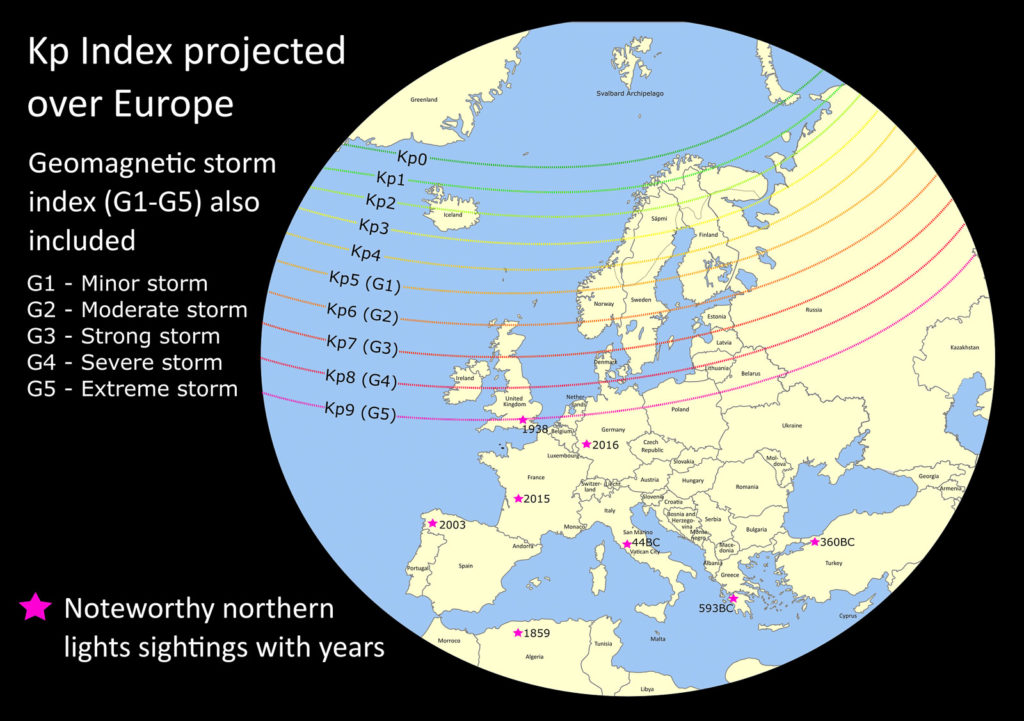
Are the northern lights really that colourful?
Many a reviewer have visited the polar regions to write articles on the northern lights. Some write about the lights as the pinnacle of their lifetime adventures, while others, increasingly so, write that the lights are not only overhyped, but a full-blown scam. Why is this? A number of factors have come together to create the illusion that all the colours are visible as bright as they look in the pictures.
What you see with the camera is not what you see with your eyes
Just as you would not see the true greens of the grass in a moonlit field as you walk through at night, the northern lights, especially weak displays, appear much less vivid than the photos would have you think (see figure 12). Don’t get me wrong, if the display is strong you will most likely see all the colours you expect to see. However, many visitors are only lucky enough to see a green band across the sky, which to the eye looks grey/green. The reason for this is the rod and cone cells of the human eye. In dark situations our eyes use rod cells, which are terrible at detecting greens and reds. In the daytime however, we use cone cells, which allow us to see a full spectrum of colours. Therefore, our eyes just aren’t that good at seeing colour at night time. That doesn’t mean the colour isn’t there, it is of course very much present, but to get enough light for it to shine to its full extent, you’ll need a very strong display or a camera to act as your eyes.
More frequently asked questions about the northern lights
The best time to see the northern lights in northern Norway is any time between September through to mid April. Although peak activity is centred around the equinox months of September-October and March-Early April. Between the hours of 18:00 and 02:00 are best for watching the lights as this is the time where the most intense section of the auroral oval passes over.
No! Contrary to what you might have heard, the temperature has no impact on the northern lights. The lights occur way too high in the sky to be affected by any temperature fluctuations near the surface.
Yes, the same mechanism causes the auroras in the southern hemisphere as it does in the north. The reason we rarely talk about the southern lights is because they are usually only seen on the fringes of Antarctica and in the far southern sky from locations such as Tasmania. These locations are not easily accessible, and have far harsher weather conditions than in the north. Therefore penguins get the best shows in the southern hemisphere.
The weather in northern Norway can change rapidly, just because is it cloudy one hour doesn’t mean it will be the next. The best option if you are unsure about the weather is to check local forecast pages such as yr.no which give an hour by hour breakdown of coming weather conditions. Even if the forecast looks terrible, all you need is a short window of clear sky to greatly improve your chances of seeing the lights.
Yes and no. Although rare, sound can be associated with large auroral displays. Finnish scientists have only recently proven what was once thought of as a myth, that yes, geomagnetic activity can cause noise. But it is not the lights themselves that are causing the noise, but rather an electrical discharge caused by temperature inversions on cold night, where cold air sits under a layer of warm air. The sound can be hissing, clapping or even a popping sound, and is centres around 70 metres above the ground. You will likely hear nothing, unless you are far away from any kind of noise pollution or screaming tourists amazed at the lights.
We cover this in our photographing the northern lights articles, however, any DSLR crop/ full frame camera and the new mirrorless systems, are going to get you good shots with the right lens. Small compact cameras simply don’t have a big enough sensor to catch the nightscape in detail, although some phones are actually getting quite good at night photography.
No! The flaming lights in the night sky pose no risk to us on the ground. However, during big solar storms, the dramatic increase in charge into the Earth atmosphere can cause radio blackouts, electrical disturbances and even cause compasses to spin. Oh, and don’t try sending any telegrams, the machines tend to erupt in flames during big solar storms.
Yes, Earth is not alone with it’s aurora displays. Jupiter, Saturn, Uranus and Neptune all have a strong magnetosphere and a dense atmosphere conductive to auroras developing. However, the lights on other planets have different colours and characteristics than our own due to different gasses in their atmospheres. For example, Saturn’s auroras are red at the base and purple at the top, while Jupiter has distinctly blue auroras.
This one is weather dependent. But in most cases, if you are caught in a city or an area with light pollution, yes, you will still be able to see the lights. There are always going to be some darker areas where you can get to, often down by the sea or in a park. Cover any light sources with your hand and look up. Of course being away from light pollution is always going to give you a less obstructed show, and for photographers, it is important to get away from too much light pollution that can ‘burn’ images.
At this current time, no. Just like with the weather, small fluctuations on the suns surface can have great consequences further down the line. For example, a coronal mass ejection can happen at any time, reaching Earth in around 48 hours, this is impossible to forecast in advance. Coronal holes on the other hand are a more consistent feature that throw solar wind our way, meaning up to a month of Kp predictions are possible, although even then, these can change at short notice. Your best bet is to make the trip and hope for clear skies, with a clear sky, anything is possible.
Equinox has great auroras
The northern lights are shape shifters
There is no uniform shape when it comes to the northern lights. However, there are certain characteristics which define different stages of an auroral display. Figure 13 is a small field guide, mainly for auroral oval zone viewers, although could be applicable to mid latitudes in rare cases too.
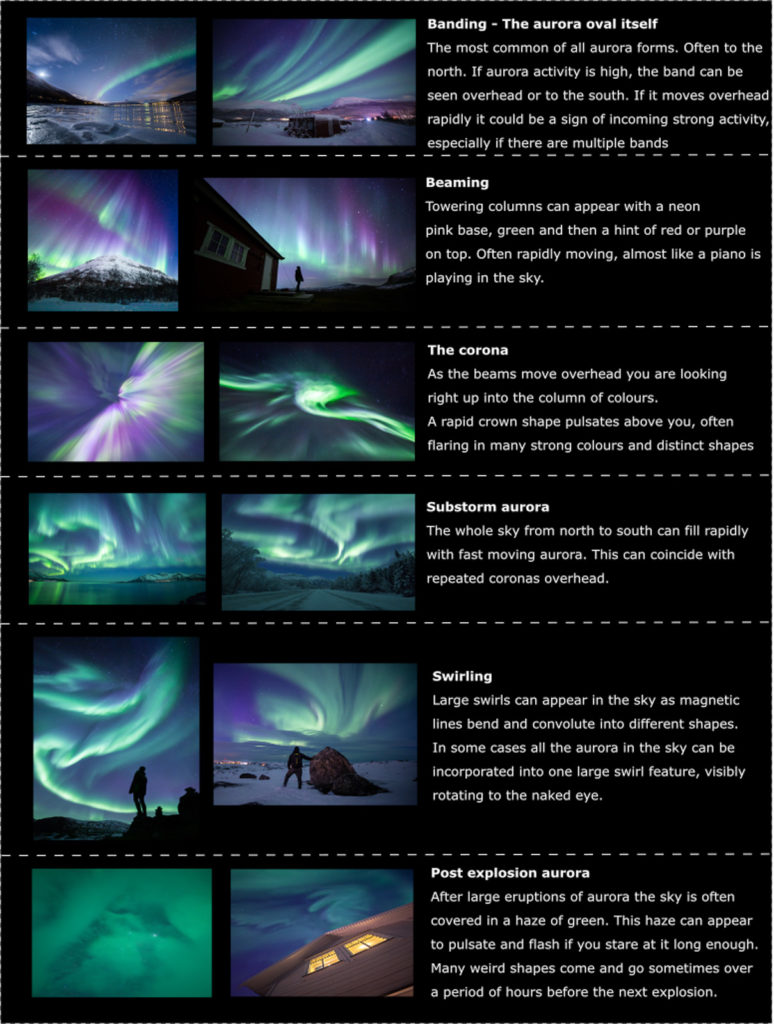
Solar storms write the history of the northern lights
Nearly all our historical records of the northern lights come from periods of solar storming. In 44BC a red glow shimmered over Rome, and is said to have foretold the death of Cesar. Meanwhile in 1938 the northern lights were so strong over London that guards called the fire engines thinking Windsor castle was alight. One of the largest storms on record occurred in 1859, with a coronal mass ejection impact holding such a punch that early telegraph communications were for the most part destroyed, magnetic reading equipment set alight, while the northern lights extended down to northern Africa, the Caribbean and some at sea even reported red on the horizon in the equatorial region.
Nearly all reports of northern lights from these low latitudes are of the colour red, this is because the lower colours of neon pink and green are hidden by the horizon (see figure 14). Another factor is that during large solar storms our atmosphere actually increases in size due to heating, allowing the oxygen to rise to higher altitudes and therefore be seen reacting over larger areas.
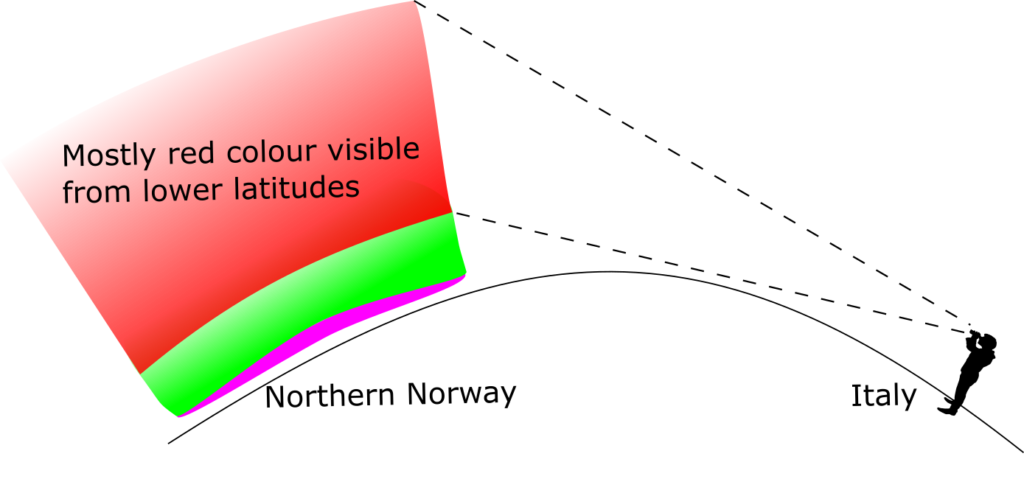
The equinox periods are proven best for northern lights chances
Solar storms occur more frequently than people think. During solar maximum you can have whole weeks dominated by geomagnetic storm after storm, while in solar minimum they are restricted to maybe 2-3 times a month. One way of increasing your chances to see a solar storm, is to visit the high latitudes during the equinox months September/October and late February/March/early April. It’s long been known that during these months our planet is better aligned to receive particles from the sun in a process known as the Russell-McPherron effect. However, the effect can sometimes act negatively on aurora chances if the wrong configuration of solar wind comes in. It must also be said that even though the effect is well known, it is an average over a long time scale, meaning you’re not guaranteed a strong display every night, but chances are increased in this window.
Some useful links
There are three vitally important sites used by northern lights guides and professionals. The first is space weather, where you can find up to date information on current space events including solar activity. The second is space weather live, where real time solar activity is tracked. And the final website is the US Space Weather Prediction Centre where you will find a lot of important information regarding current activity and even more frequently asked questions. Used in conjunction, you’ll be in the know for when you try to catch a glimpse of the lights.
To sum up
So what are the northern lights? If you’ve managed to read this far you’ll know that the answer is not a simple one. The science may not be a thrilling topic for some, but to understand even the most basic of northern lights science can really help when embarking on your trip to see the lights. You will be able to understand much of the terminology sites and companies use and also be in a better place to make your own decisions about your chances. Always remember though, however good the solar activity may be, your chances of catching the lights are nearly always weather dependent. Check the weather forecast first, and then the solar activity.
About the author
William Copeland is originally British but has lived in Northern Norway for many years. He came to study geology at Tromsø University and later specialised in marine geology and geophysics. Alongside his studies, he worked as a northern lights guide from 2016 to 2019, cumulatively taking thousands of visitors on northern lights chase tours. Despite no longer guiding, William still spends most of his time researching, photographing and predicting the northern lights, alongside photography of Northern Norway’s vast landscapes and shifting weather.
